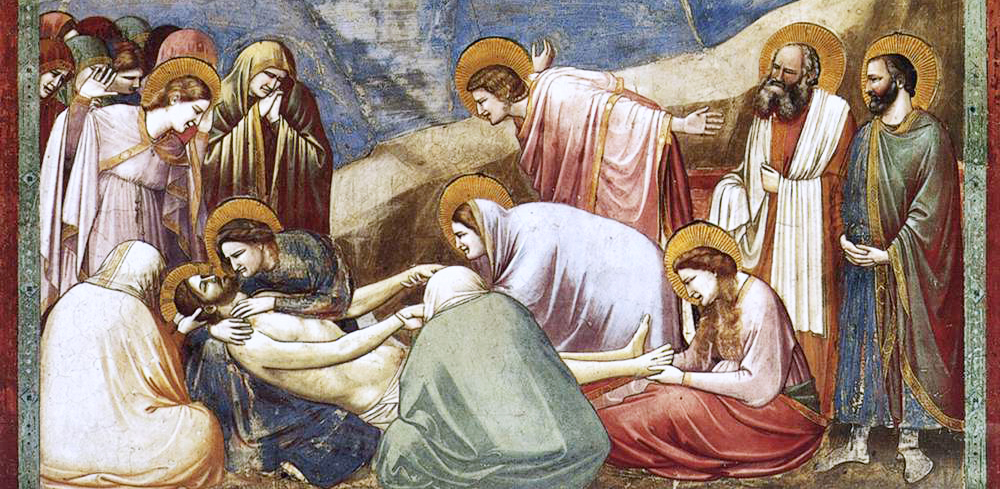
19 Mar The Gift of Holy Saturday
I answer that it was fitting for Christ to be buried… because by Christ’s rising from the grave, to them who are in the grave, hope is given of rising again through Him.
Thomas Aquinas, ST, IIIa.q51
I wonder what thoughts were running through Nicodemus’s mind and what feelings governed his heart as he accompanied Joseph of Arimathea to the tomb to bury the body of Jesus? In his account of the burial of Jesus following the crucifixion at Golgotha, the writer of John’s gospel is quick to note that this is the same Nicodemus who had previously visited Jesus at night (Jn. 19:39), the pharisee Nicodemus to whom Jesus said: “no one can see the kingdom of God without being born again and that just as Moses lifted up the snake in the wilderness, so the Son of Man must be lifted up [or exalted] that everyone who believes may have eternal life in him” (Jn. 3:3; 14–15).
He comes well prepared to bury Jesus. We are told that Nicodemus brings 35 kilograms of a mix of myrrh and aloes to prepare Jesus’s body for burial in the garden tomb. That’s a lot of spices. By way of comparison, commentators note how much more it is than the perfume that Mary pours out on Jesus at Bethany (Jn. 12:1–8). This is the amount that would be used for the burial of a king. It’s yet another detail that reinforces the portrayal in his suffering of Jesus as King, from the crown of thorns and purple robe that the soldiers use to dress Jesus to the notice that Pilate orders to be placed on the cross: JESUS OF NAZARETH, THE KING OF THE JEWS.
Presumably, Nicodemus has been party to the events of Jesus’s crucifixion or least been told about them: this macabre coronation, ending with the enthronement of Jesus on the cross. The irony should not flit by us: the King of all Creation has been enthroned by his own creatures on a dreadful wooden throne (if I am ever in doubt about the depths of perversity and blindness to which we humans can descend, the crucifixion of God incarnate is an antidote to my idealism). Yet, this same enthronement—this lifting up of the Son of Man like Moses lifting up the snake in the wilderness—is, in the mysterious workings of God, the victory of creation’s King over the enemies of sin and death.
As I meditate on this burial story, I imagine Nicodemus wrapping the body of Jesus with Joseph of Arimathea while turning over the words of Jesus to him… the Son of Man must be lifted up, that everyone who believes may have eternal life in him… the Son of Man must be lifted up, that everyone who believes may have eternal life.
“Yes, the Son of Man has been lifted up,” Nicodemus thinks, “but eternal life in him?”
“I’m wrapping his dead body; the King is dead.”
“But God so loved the world that he gave his one and only Son, that whoever believes in him shall not perish but have eternal life.”
Then I imagine a spark igniting somewhere in Nicodemus’s mind, igniting a small and precarious fire, but a fire of hope nonetheless. I imagine this fire growing, such that when Nicodemus watches the tomb being sealed, he wonders:
“Yes, the King is dead.
But, long live the King?”
Nicodemus then leaves the garden with that precarious fire of hope still burning and a growing sense of anticipation as he enters into the night…
***
It’s easy to skip past the burial of Jesus and to move in one quick step from Jesus’s final cry on the cross “It is finished” to Mary’s declaration to the disciples, “I have seen the Lord!” The gospels and the wider apostolic testimony concerning Jesus, however, do not do so. Consider Paul in 1 Corinthians 15:3–5:
For what I received I passed on to you as of first importance: that Christ died for our sins according to the Scriptures, that he was buried, that he was raised on the third day according to the Scriptures, and that he appeared to Cephas, and then to the Twelve.
This emphasis on the burial of Jesus is, in part, apologetic: Jesus really did die at the cross, and the preparation of his dead body and its burial in the tomb attests to this fact. But this apologetic aspect does not exhaust Christian reflection on Jesus’s burial. For example, I think that it is significant that once Jesus cries out on the the cross “It is finished,” he is buried in the tomb where he rests on the Sabbath day (the seventh day of the week). Just as God rests from his work of creation on the seventh day, so, now, Jesus rests in the tomb from his work of salvation, which he has finished at the cross, on the seventh day of the week. The parallels here between the events of Easter and Genesis 1 are meant to build hope that God might be up to something new—to instil hope that this might be a moment of new creation!
So, also, I think Paul sees Christ’s burial as crucial for us in a life marked by hope. Consider his words in Romans 6:1b–4:
Shall we go on sinning, so that grace may increase? By no means! We are those who have died to sin; how can we live in it any longer? Or don’t you know that all of us who were baptised into Christ Jesus were baptised into his death? We were therefore buried with him through baptism into death in order that, just as Christ was raised from the dead through the glory of the Father, we too may live a new life.
Just as Jesus was buried in the tomb, so we have been buried with him in baptism, wherein we have died to sin. And it is from this place of burial that we anticipate rising with him—yes, eventually when we are given resurrection bodies but also daily as we rise to new life in the power of the Holy Spirit. Just as Jesus’s burial is laced with hope, so, too, our burial in baptism is laced with hope for the eventual defeat of death but also the daily victory over sin and the Holy Spirit’s ongoing activity in our lives.
The Christian life, then, is meant to be marked by daily hope. Faith takes hold of the reality of what God has accomplished for us in Jesus Christ in loving trust; hope anticipates God’s ongoing work in our lives, including his guidance, provision, compassion, and power to defeat temptation and to persevere in difficulty.
The gift of Holy Saturday is that it brings us to a place of hope. Christ has completed his work: “It is finished.” Yet resurrection is still to come. But from the place of burial there is the hope of resurrection, just as from the place of our burial in baptism there is the daily hope of God’s ongoing work of resurrection in our lives. The tomb is a tomb of hope. This is the gift of Holy Saturday.
(Image: “Lamentation (The Mourning of Christ),” Giotto di Bondone, CC Zero)

